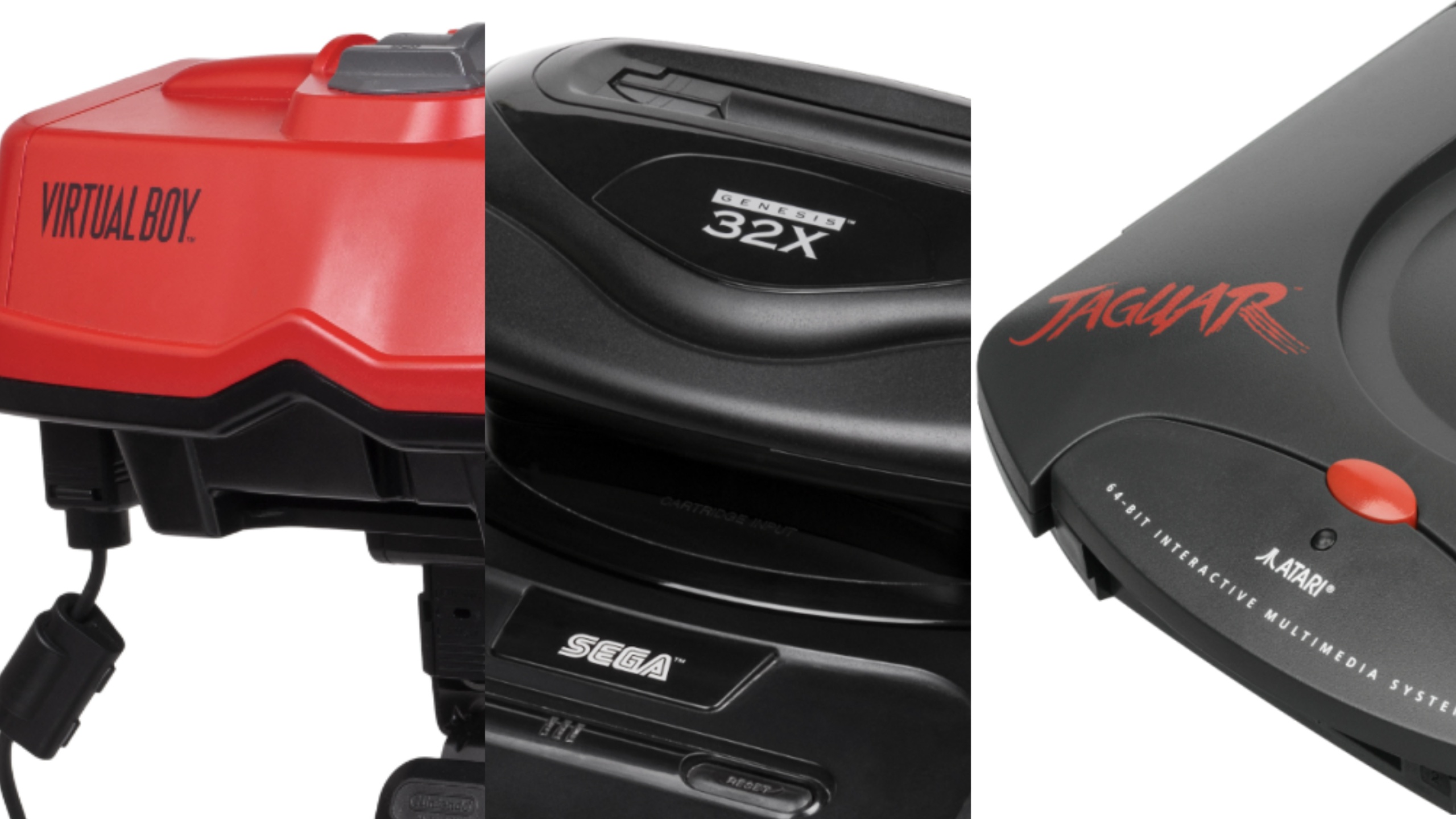
Video game consoles are a hell of a thing when you think about it. It’s one big gamble where we hope that we can keep throwing money at it and we’ll constantly be rewarded with more fun and enjoyment. If you bought a Switch during its first year and you’re still playing it now, then congratulations; you and Nintendo succeeded. On the other hand, you might have a Wii-U sitting around, collecting dust. Sorry about that.
While there are plenty of console and handheld success stories in the industry, there are those companies who put a bunch of resources together, shoved it out the door, and then winced as it suddenly collided with reality. Consoles that failed for one reason or twenty others and only exist as nostalgia mixed with schadenfreude.
That’s not to say that financial failure automatically ropes you in with bad quality. Consoles like the Wii-U and the 3DO crumbled, but they weren’t the worst things ever. They had their moments. No, the worst things ever are the fifteen entries below.
*Photos from the Vanamo Online Game Museum
15. Sega 32X
The idea of the 32X was arguably sound. It was an add-on to the Sega Genesis that would have its own library of enhanced games. Unfortunately, the timing of its release was horrible and the attachment fell flat. It already felt redundant when compared to the Sega CD: the other Genesis attachment that promised a spruced-up gaming experience. The Sega CD at least had a stronger sense of identity. It also didn’t help that the 32X came out roughly the same time as the Sega Saturn (a few months before for the US, a couple of weeks later for Japan), which really stole its thunder as a hardware superstar.
Even though the device was released way too late, it still was rushed into development and its library shows it. While there are some good titles in there, developers did not have the time to truly play with what the 32X was capable of and few games truly met its full potential. In the end, it was another notch in the belt of Sega’s downfall as a hardware giant.
14. Atari Jaguar
Speaking of Sega’s downfall, one thing you won’t see on this list is the Sega Dreamcast. Despite being the final nail in the coffin for Sega in the console game and a financial failure, it’s still a beloved machine with its share of absolute classics and awesome ports. The nostalgia is strong for Sega’s final gasp, but the same can’t really be said for its Atari counterpart: the Jaguar. Truth is, the Atari Jaguar just wasn’t very good.
Outside of a few standout games (Alien vs. Predator comes to mind), Jaguar’s library didn’t exactly set the world on fire. Apparently, its messy hardware was a turn-off to a lot of developers, causing some major companies to ignore it completely. Add a laughably bad controller that nobody liked and the Jaguar was doomed from the start. Despite its brand recognition and dubious claims of being a 64-bit console in a 16-bit era, the Jaguar just could not compete with the SNES and Genesis. Once the next set of consoles hit the scene and succeeded in being what Jaguar pretended to be, there was no coming back.
13. Nokia N-Gage
The N-Gage was so close, but so far away. They almost had something. A phone/gaming hybrid was something that was going to be a major deal years later, but Nokia just did not have the chops to realize it in the right way. It didn’t work well as a handheld gaming device and it did not work especially well as a phone. It was filled with iffy design choices, like the ways the buttons were mapped out and the fact that you had to remove the battery just to change your game.
That’s not to say that it was all bad. The N-Gage was technically more powerful than the Game Boy Advance, but certain games were trying to punch way above their weight class (ie. most of the games with 3D graphics, like Call of Duty and Tomb Raider). The vertical screen was a baffling design flaw, but at least there were a few games that went well with that, like Tony Hawk’s Pro Skater and Mile High Pinball. In hindsight, the N-Gage really could have been something more than a laughing stock it ended up becoming.
12. Nintendo Virtual Boy
Nintendo has made some missteps over the years, but this is the one that literally hurts to look at. Back in 1995, they released their “virtual reality” portable console that supported 3D visuals. It sounded nice, but those graphics were either black or several shades of red, which isn’t exactly the most appealing combination of colors to practically press your eyes against. It was an expensive novelty that nobody wanted to invest in. Hell, few Virtual Boy games even bothered to embrace the first-person gimmick and utilize one of the biggest reasons the device existed. That reminds me; Nintendo needs to bring back Teleroboxer.
The Virtual Boy eventually became little more than a curiosity. In the grand scheme of things, it barely made a dent in Nintendo’s legacy, but it did show that they were more than capable of dropping the ball.
11. SouljaGame
There are several of these, but let’s just lump them together.
Starting in 2018, rapper Soulja Boy announced that he was going to be releasing his own video game console. Not on my bingo card, but sure, let’s go with that. Various consoles came out and it became very apparent very quickly that not only were these emulation boxes (ie. the rom collections you see on Amazon that hype up “500,000 GAMES!” with a random image of Ryu from Street Fighter), but they were existing emulation boxes with a new logo slapped onto it and a huge markup price.
While the quality of these repackaged consoles is all over the place and they technically are full of classics from decades past, it’s still a hilarious scam that went south the second Soulja Boy taunted Nintendo’s lawyers and immediately regretted it. It may not technically be the worst console, but it’s definitely one of the biggest punchlines.
10. Phillips CD-i
The 90s was such a magical time for failed consoles. Starting around the introduction of the Sega Genesis and ending around the release of the Sony PlayStation, there were just so many throwaway attempts to jump onto the future of gaming that never went anywhere. While everyone was perfectly happy with the major players in the 16-bit console war, there was always some company throwing out a big hunk of technology with a $600 price tag and hoping for the best. If they were lucky, they would be mentioned in EGM or Gamepro. Most of the time, though, they would be forgotten or become cautionary tales.
The CD-i was the epitome of that moment in gaming. The device that nobody wanted, especially for its historically high launch price of $799 (a little over $1800 today). Yet, the CD-i managed to linger for a lengthy period of time despite its almost complete lack of appeal. While it was developed for more video than gaming, its infamy will always be tied to its Mario and Zelda titles. It’s one thing to make a bad game, but making historically bad games based on properties that are brilliant elsewhere is a stink you just can’t get rid of.
On that note, more people need to see the wonderful weirdness of Mutant Rampage: Bodyslam. It’s a side-scrolling beat ‘em up that has similar cutscenes to the CD-i Zelda games (it was made by the same people) but with way better quality that makes it feel more like something out of a Don Bluth film.
9. Commodore 64 Game System
It was 1990 and Commodore International wanted to get into the console business. Good for them, as they rightfully made a name for themselves with 1982’s Commodore 64 home computer. There were countless games on that computer and surely the next step in their evolution had major potential.
The problem was that the strategy for the Commodore 64 Games System was to simply release their home computer in a new form but without the pesky home computer stuff in there. Yes, the console was based on tech that was 8 years old and was scheduled to be released a year after the Sega Genesis and a month after the SNES.
Not only was there no notable support for it outside of developer Ocean, but there was a major problem with its design. As they had removed the keyboard (after all, what kind of console needs a keyboard?), many of the original Commodore 64 titles were unplayable for the Commodore 64 Game System. On top of that, Terminator 2 (a game specifically made for the Commodore 64 Game System) required keyboard use. Funny enough, they made the same mistake decades later with the C64 Mini.
8. Casio PV-1000
When Casio released their console months after the Famicom, they knew immediately that they had made a tremendous mistake. The console hit the market with a gigantic thud and they accepted very early on that the quicker they stepped away, the better. It only released thirteen games and it never left Japan. Instead, they moved on to the PV-2000, which was more of a computer than a console, though it was compatible with the PV-1000’s controller. Not the games, though. The PV-2000 had only eleven of those and there was no cross-compatibility between the two machines.
Casio would try their luck again a decade later, realizing that they needed a gimmick in order to stand out. The result, the Casio Loopy, was based on the gimmick that it was made specifically for girls, complete with eleven stereotypical games to go with it. Once again, it did not catch on and Casio realized they should stick to keyboards and calculators.
7. Tiger Gizmondo
The Gizmondo was a handheld that had certain smartphone concepts built-in, most notably a GPS, and the hardware specs were nothing to sneeze at. In the right hands, it could have been something special. Unfortunately, the people at Tiger Telematics were using their own hands to cut their cocaine supply into lines.
The top brass had some rather overzealous ideas about how to spend money on the console, including a star-studded release party in London, a store made specifically for selling the Gizmondo and its games, and even executive Stefan Eriksson driving a Gizmondo-sponsored Ferrari in the 2005 24 Hours of Le Mans race. It should be noted that this is not the same Ferrari that Eriksson totaled so badly from driving under the influence that it was literally cut in half from the damage.
Between all of that extravagance and the horrific sales, Tiger Telematics went bankrupt within a year. While they were likely doomed no matter what, part of the problem was that they were going to release a better version of the Gizmondo with widescreen and made the mistake of telling that to the public before the first one came out. Great job! Your lack of foresight cost us a Carmageddon port.
6. Game Wave Family Entertainment System
Released in 2005, the Game Wave was essentially just a DVD player MacGyvered into something resembling a console. Because of this technology, none of the games are AI-based in any way but are instead just an elaborate set of menus manipulated by four remote controls. Because of that, all of the console’s 13 games are trivia or puzzle-based.
In a perfect world, this would mean you could at least play something interesting (though incredibly stupid) like Plumbers Don’t Wear Ties. Incredibly, though, the Game Wave was intended to be a family console with a Christian bend to it. Hence, even though there were off-brand knockoffs of Trivial Pursuit, Wheel of Fortune, and so on, they did get that sweet VeggieTales license action with VeggieTales: Veg-Out! Family Tournament. It was just a collection of minigames and trivia that tried to jump onto the Mario Party train.
5. Apple Bandai Pippin
Finding out that Apple and Bandai collaborated on a console is like when you hear about the Nintendo PlayStation. Surely, it was just some kind of prototype that never made it to the next stage, right? But no, back in the mid-90s, these two companies came together to create a $600 piece of hardware that fell flat on its face.
The Pippin wanted to embrace the concept of an internet connection before it was something the public truly wanted and it didn’t work all that well to begin with. Some of the design choices were questionable at best, like how there was no dedicated graphic or sound processor, forcing the CPU to tax itself.
The library featured plenty of educational releases and even the attempts at actual games left a lot to be desired. Bandai’s involvement meant they got to dip their toes into the Power Rangers franchise, but Power Rangers Zeo Versus the Machine Empire is a hideous mess. Yes, the graphics were technically more advanced than something you’d see on a 16-bit system, but it was also janky and controlled like crap.
Anyway, is there any update on when Better Homes and Gardens Cool Crafts is being ported to the Switch? Actually, is it on the SouljaGame?
4. Gakken Compact Vision TV Boy
Talk about being late to the party. Released ever-so-briefly in Japan, Gakken’s console was more on the graphical level of the Atari 2600 and came out only months after the Famicom. It simply had no chance, especially with its very basic library of six games. It had Frogger, at least! That’s a point in its favor.
The main thing that made the Gakken Compact Vision TV Boy stand out was also one of its biggest drawbacks: the console’s controller was attached to the console itself. It’s actually a fascinating design. On the left was a handlebar with a button on it, and the joystick was closer to a gear shift with a button on the end. I can’t say how comfortable that would have been in the long run, but it at least looks neat. The problem was that when your console is the controller, that pretty much eliminates the possibility of any two-player experiences. Hence, all of the games were single-player.
3. VM Labs Nuon
At first glance, the Nuon appears to be yet another CD-based device that barely counts as a video game console. After all, it was based around being an enhanced DVD player that had special bells and whistles for a select few DVD releases (merely four in total). Shockingly, the video game aspect of the Nuon is legit and there was some serious potential there. Too bad there are only eight games with some serious playability issues.
There were multiple releases of the Nuon with multiple kinds of controllers. That meant that certain games were not compatible with different Nuons or their controllers. For instance, Freefall 3050 AD could only be fully controlled due to some extra buttons that were not on every controller design.
Otherwise, it was useless. Crayon Shin-chan 3 was a Korean-only release and the Korean Nuon couldn’t play any of the other games! Ballistic could only be played on Samsung players. I swear, with only eight games, you should not need to make flowcharts to figure out how to play them.
At the very least, I’ll give the Nuon some love for having The Adventures of Buckaroo Banzai Across the 8th Dimension as one of its tie-in DVDs. It gives me an excuse to rock out to the movie’s end credits theme. Everybody walk with me for no reason!
2. Tandy Memorex Video Information System
First off, why would any child be interested in something named that? Even with there being a word with an X in it, it’s just so dull and lifeless.
The VIS was a Radio Shack exclusive that ran on Windows and came out in 1992. At Radio Shack it stayed as nobody wanted to buy the $700 machine. A lot of its releases were educational stuff and story books for children, though there were a small handful of actual games in there. Nothing exciting, as it was stuff like golf, a couple Sherlock Holmes mysteries, a game about a talking dog trying to murder Dracula. Your usual droll—wait, that last one sounds awesome.
The VIS ended up being like a lamer CD-i, without the novelty of those goofball Nintendo titles.
1. Mattel Hyperscan
Several entries on this list come with the feeling that they were trying for something inventive that just did not work. Maybe it was a brilliant idea that was so ahead of its time that the technology wasn’t there yet. Maybe it was the lack of funding or competence. At least I can respect what most of them were trying. The Mattel Hyperscan, on the other hand, is a garbage console that deserved its failure.
Let’s ignore the minuscule amount of games. Let’s ignore how lousy they ended up. The Hyperscan’s whole concept was lootbox DLC in console form. You buy the game, you get a few trading cards that you scan to allow in-game access to stuff, and then you buy packs of cards in hopes of being able to unlock other aspects of the game. Oh, you wanted to play as Iron Man in the Marvel Heroes game? Too bad! Buy some card packs and maybe you’ll get your wish. If that doesn’t work? Buy some more!
The post 15 Worst Video Game Consoles Ever appeared first on Den of Geek.





